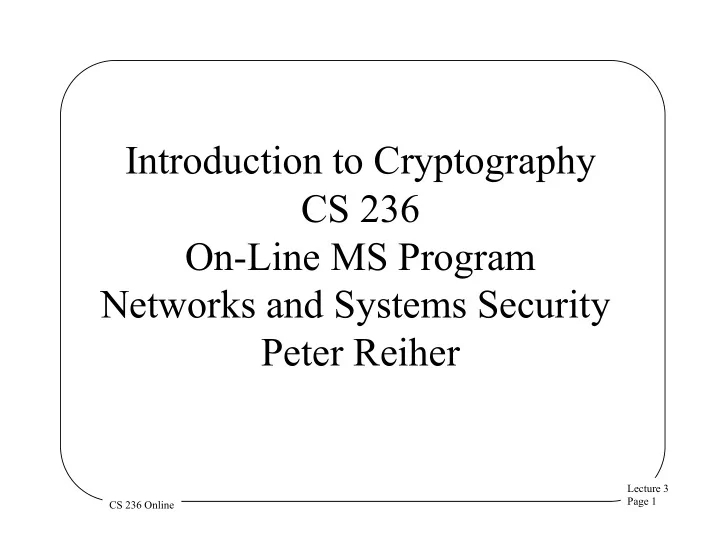

Introduction to Cryptography CS 236 On-Line MS Program Networks and Systems Security Peter Reiher Lecture 3 Page 1 CS 236 Online
Outline • What is data encryption? • Cryptanalysis • Basic encryption methods – Substitution ciphers – Permutation ciphers Lecture 3 Page 2 CS 236 Online
Introduction to Encryption • Much of computer security is about keeping secrets • One method is to make the secret hard for others to read • While (usually) making it simple for authorized parties to read Lecture 3 Page 3 CS 236 Online
Encryption • Encryption is the process of hiding information in plain sight • Transform the secret data into something else • Even if the attacker can see the transformed data, he can’t understand the underlying secret Lecture 3 Page 4 CS 236 Online
Encryption and Data Transformations • Encryption is all about transforming the data • One bit or byte pattern is transformed to another bit or byte pattern • Usually in a reversible way Lecture 3 Page 5 CS 236 Online
Encryption Terminology • Encryption is typically described in terms of sending a message – Though it’s used for many other purposes • The sender is S • The receiver is R • And the attacker is O Lecture 3 Page 6 CS 236 Online
More Terminology • Encryption is the process of making message unreadable/unalterable by O • Decryption is the process of making the encrypted message readable by R • A system performing these transformations is a cryptosystem – Rules for transformation sometimes called a cipher Lecture 3 Page 7 CS 236 Online
Plaintext and Ciphertext • Plaintext is the original Transfer $100 to my form of the message savings (often referred to as P ) account • Ciphertext is the Sqzmredq #099 sn lx encrypted form of the rzuhmfr message (often referred zbbntms to as C ) Lecture 3 Page 8 CS 236 Online
Very Basics of Encryption Algorithms • Most algorithms use a key to perform encryption and decryption – Referred to as K • The key is a secret • Without the key, decryption is hard • With the key, decryption is easy Lecture 3 Page 9 CS 236 Online
Terminology for Encryption Algorithms • The encryption algorithm is referred to as E() • C = E(K,P) • The decryption algorithm is referred to as D() – Sometimes the same algorithm as E() • The decryption algorithm also has a key Lecture 3 Page 10 CS 236 Online
Symmetric and Asymmetric Encryption Systems • Symmetric systems use the same keys for E and D : P = D(K, C) Expanding, P = D(K, E(K,P)) • Asymmetric systems use different keys for E and D: C = E(K E ,P) P = D(K D ,C) Lecture 3 Page 11 CS 236 Online
Characteristics of Keyed Encryption Systems • If you change only the key, a given plaintext encrypts to a different ciphertext – Same applies to decryption • Decryption should be hard without knowing the key Lecture 3 Page 12 CS 236 Online
Cryptanalysis • The process of trying to break a cryptosystem • Finding the meaning of an encrypted message without being given the key • To build a strong cryptosystem, you must understand cryptanalysis Lecture 3 Page 13 CS 236 Online
Forms of Cryptanalysis • Analyze an encrypted message and deduce its contents • Analyze one or more encrypted messages to find a common key • Analyze a cryptosystem to find a fundamental flaw Lecture 3 Page 14 CS 236 Online
Breaking Cryptosystems • Most cryptosystems are breakable • Some just cost more to break than others • The job of the cryptosystem designer is to make the cost infeasible – Or incommensurate with the benefit extracted Lecture 3 Page 15 CS 236 Online
Types of Attacks on Cryptosystems • Ciphertext only • Known plaintext • Chosen plaintext – Differential cryptanalysis • Algorithm and ciphertext – Timing attacks • In many cases, the intent is to guess the key Lecture 3 Page 16 CS 236 Online
Ciphertext Only • No a priore knowledge of plaintext • Or details of algorithm • Must work with probability distributions, patterns of common characters, etc. • Hardest type of attack Lecture 3 Page 17 CS 236 Online
Known Plaintext • Full or partial • Cryptanalyst has matching sample of ciphertext and plaintext • Or may know something about what ciphertext represents – E.g., an IP packet with its headers Lecture 3 Page 18 CS 236 Online
Chosen Plaintext • Cryptanalyst can submit chosen samples of plaintext to the cryptosystem • And recover the resulting ciphertext • Clever choices of plaintext may reveal many details • Differential cryptanalysis iteratively uses varying plaintexts to break the cryptosystem – By observing effects of controlled changes in the offered plaintext Lecture 3 Page 19 CS 236 Online
Algorithm and Ciphertext • Cryptanalyst knows the algorithm and has a sample of ciphertext • But not the key, and cannot get any more similar ciphertext • Can use “exhaustive” runs of algorithm against guesses at plaintext • Password guessers often work this way • Brute force attacks – try every possible key to see which one works Lecture 3 Page 20 CS 236 Online
Timing Attacks • Usually assume knowledge of algorithm • And ability to watch algorithm encrypting/ decrypting • Some algorithms perform different operations based on key values • Watch timing to try to deduce keys • Successful against some smart card crypto • Similarly, observe power use by hardware while it is performing cryptography Lecture 3 Page 21 CS 236 Online
Recommend
More recommend